The noise thundered loud enough to occasionally reverberate through the press room, where Charl Schwartzel tried to sum up his victory in the first-ever LIV Golf Invitational Series event outside of London.
The South African golfer, who won the Masters in 2011, was among a surprisingly high number of past major champions to sign up for the controversial new circuit. He was reveling in the fact that the $4.75 million he had just earned for his individual and team victories was more money than he had accumulated in official earnings over the past four seasons combined.
The music boomed from a fully constructed concert venue at the Centurion Club, soon to be replaced by a celebratory podium ceremony in which Yasir Al-Rumayyan, a self-admitted golf nut, would step up to the microphone, beaming.

Jonathan Ferrey/LIV Golf/Getty Images
In less than three months, LIV Golf—with Hall of Famer Greg Norman as its CEO and commissioner—announced an eight-tournament schedule, signed the likes of Phil Mickelson, Dustin Johnson, Sergio Garcia and Louis Oosthuizen to massive guaranteed contracts, and staged a tournament complete with a live internet broadcast, spectators and a $25 million purse.
Al-Rumayyan is the governor of the Public Investment Fund (PIF), the Saudi Arabian investment arm that is bankrolling LIV Golf. He serves under Mohammed bin Salman—also known as MBS—the country’s crown prince and prime minister. He explained the meaning of LIV, the Roman numeral 54. He noted that number would be a “perfect score” in golf—a birdie on each of 18 holes.
And then Al-Rumayyan dropped this beauty from the podium: He said if any LIV player ever shot a score of 54, he’d be paid a bonus of $54 million.
The crowd cheered, Al Rumayyan smiled, and it didn’t matter if he was kidding: The fact that the PIF, with its hundreds of billions of dollars, can easily afford it was all you needed to know about the funding mechanism that took LIV Golf to this point.
Greg Norman had long believed that the stars in the game were under-compensated. The Australian, nicknamed the Great White Shark, was a mega-star in the 1980s and ’90s and ranked No. 1 in the world for 331 weeks, longer than any player not named Tiger Woods.
He was also in demand and attempted to take advantage of it. Norman, who won 20 times on the PGA Tour, had another 60-some victories around the world. At his height, he could command high-six-figure appearance fees to play in Europe and Asia and in his native Australia. He, like any top player, wanted to cash in on his success.
So he would fulfill his obligation of playing a minimum of 15 PGA Tour events per year while also playing around the world, raking in the cash. The problem: The PGA Tour, which owns a player’s media rights, would only allow such excursions three times. Beyond that, you needed permission. And that permission often came with a price, such as a favor that included playing more events.
“It still frustrated me to death why as an independent contractor I couldn’t get out there and expand on my true market value that I truly believe I had,” Norman said. “Same with all the other players.”
Thus were born the seeds of LIV. Norman tried to start a rival tour in 1994, the World Golf Tour, that would have limited fields, no cuts and big purses. (That is the framework of LIV Golf.) He even had Fox agree to televise the events and apparently had the support of several players.
But Norman was thwarted in his attempts to get it off the ground. Then-PGA Tour commissioner Tim Finchem threatened players with suspensions or bans if they joined, using the Tour’s conflicting events regulations as his basis. Players backed off. And Norman’s dream died.

LIV Golf and its forerunner, the Premier Golf League—which had the same basic structure but was in the developmental stages years ago—already had a plan in place when Norman was brought in last summer, behind the scenes, as its CEO. It was late October when he was named commissioner, after several delays in announcing who would participate in this new endeavor.
At times it appeared doomed, none more so than in the wake of Mickelson’s stunning comments from a book excerpt that not only took on the PGA Tour but were also highly critical of the Saudi regime with which he was negotiating for a huge payday. The regime has been associated with extensive human rights violations, the 9/11 attacks on America and the 2018 murder of Washington Post reporter Jamal Khashoggi.
Rumors circulated about big-money guaranteed contracts being offered as LIV Golf kept teasing a big announcement, only for it to be scrapped and delayed and, ultimately, seemingly thwarted.
But after numerous setbacks, LIV Golf announced its schedule in March, and what has followed has been a highly disruptive, polarizing story that has produced numerous twists and turns throughout the summer with one underlying theme: money.
The excess was apparent from the start. LIV Golf decided to play its first event overseas, despite all the logistical hassles that would entail. The Centurion Club outside of London might not have been the greatest golf course in the U.K., but it was available and willing to stage the first 54-hole event in LIV’s existence—for a hefty rental fee.
Of course, it was not all about the golf. Each event has been preceded by a lavish party on the night before the pro-am—an 18-hole event in which amateurs on the PGA Tour typically pony up anywhere from $6,000 to $20,000—for the right to be grouped with a professional golfer.
The first one, at RD Studios in London, was the most extravagant. It was where the first “draft” of LIV Golf teams took place, with theater seating, musical entertainment, drinks flowing and more food than double the number of people in attendance could consume.
That party alone was said to cost $3 million, and there have been others along the way, such as at Gotham Hall in New York City in conjunction with the Bedminster, N.J., tournament and Mechanic’s Hall outside of Boston and a car museum outside of Chicago. Part of these bashes involve sorting out the pro-am groups, which is pretty standard at golf events. It’s the opulence that is different.
Even in Saudi Arabia, where alcohol is not allowed, LIV Golf put on a pre-tournament party on the beach along the Red Sea with camels, music and enough food to feed all of King Abdullah Economic City.
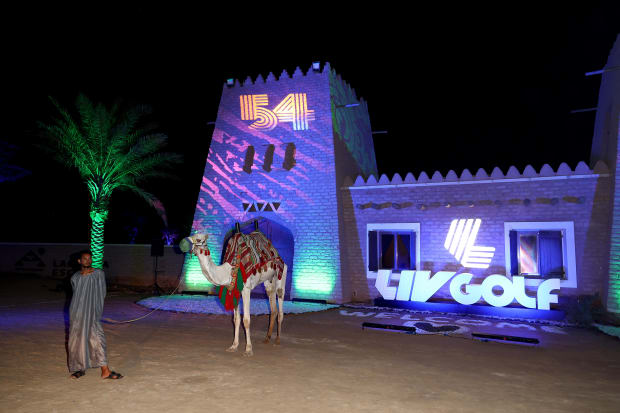
Joe Scarnici/LIV Golf/Getty Images
At the London event, organizers used the famous London cabs to transport players to holes on the course. (In Thailand, they used tuk tuks—mini-cabs found throughout Bangkok.) Because LIV Golf events are shotgun starts, everyone starts at the same time on different tees around the course. Traditionally, players would take golf carts out to the holes.
The cabs lined the parking lot, with hole numbers posted in the windshield to determine who would ride in each one out to their respective holes. After dropping the players off, the cab driver returned to the parking lot and basically had five hours to kill until picking them up. “I’ll make more today sitting here doing this than I would have if I was driving the cab all day,” said one of the drivers.
That is another common theme with LIV Golf. Those who do work for the circuit are amply compensated. Television production people who typically work on a freelance basis for various networks or entities around the company are paid a day rate. Many report it being more than they normally earn.
A car driver working the event outside of Chicago reported receiving $600 a day for shuttling players and caddies between the hotel and the golf course—or wherever else they wanted to go. No courtesy cars with LIV Golf. Players are chauffeured around in high-end SUVs.
Then come the player perks. “I’m used to spending more than $150,000 a year in travel, and I never was flying on a private plane,” says Pat Perez. “What they are doing here is unreal.”
Each player gets four airline tickets per tournament. Their hotels are taken care of, too, such as the five-star Mandarin Oriental in Bangkok. They have transportation to and from the airport, to and from the course, to and from anywhere else they want to go when not playing.
Meals are provided at the hotel, so the only time a player shells out is when he wants to take a meal somewhere else. He also pays his caddie, which is made far easier with the huge purses that guarantee a minimum of $120,000 per tournament for the last-place finisher.
In perhaps the most extreme display of accommodating the players, LIV Golf changed the dates of its Portland event to end on Saturday when it was learned that more than a dozen players had previously signed up to play in the two-day JP McManus Pro-Am at Adare Manor (site of the 2027 Ryder Cup) in Ireland the following Monday.
LIV Golf chartered a jet, and the players piled in on Saturday night after Branden Grace won the tournament, heading eight time zones away in style. Video surfaced a few days later of players living it up on the aircraft while “We Are the Champions” blared in the background.
“You are not going to lose money even if you have a bad week,” says Australia’s Marc Leishman, who joined LIV Golf prior to the fourth event in Boston. “For me the coolest part is the camaraderie. We’re all together, eating and drinking at the hotel or having breakfast with the other players.
“But having said that, where we came from [the PGA Tour] was pretty good, too.”
Leishman, 39, won six times on the PGA Tour and has more than $35 million in official career earnings. So imagine how a less prominent player feels about all the riches bestowed upon those competing in LIV Golf.
Perez, 46, signed a four-year deal with LIV Golf believed to be worth $10 million. “I couldn’t be happier,” he says. “Look, I know I can’t beat those kids anymore. This was a great opportunity for me. I have nothing against the PGA Tour; they did a lot for me, but I had to earn everything I got out there.”
Despite not finishing better than 16th in any event, Perez has been able to cash in due to his affiliation with the 4 Aces team captained by Johnson. The four-man team won four of the seven team competitions (individual scores were compiled to create team scores), splitting $3 million for each. That alone meant another $3 million to Perez, who won three times on the PGA Tour over 22 seasons.
For all the talk about Mickelson and Johnson and British Open champion Cameron Smith and Brooks Koepka and Bryson DeChambeau, there are also longtime players such as Charles Howell III, Kevin Na and Harold Varner III, who cashed in with light résumés. Howell, 43, was known for being a human ATM, earning more than $40 million in his PGA Tour career—among the Tour’s top 20 money leaders all-time—while winning just three times. Na, 39, won five times. Varner, 32, has no PGA Tour wins but captured the Saudi International tournament title in February by finishing birdie-eagle for a dramatic win over Bubba Watson. That victory propelled him up the world rankings and into the Masters—a tournament he may never see again.
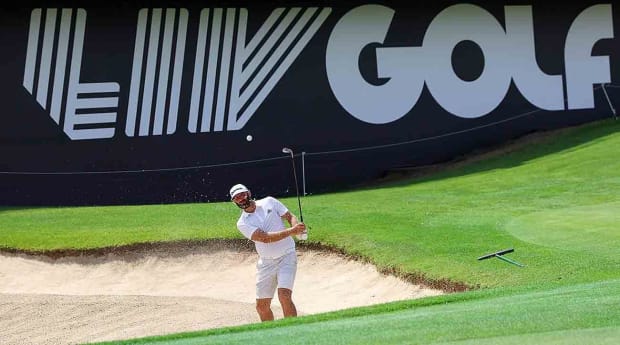
Courtesy of LIV Golf
Peter Uihlein lost in a playoff to Koepka in Saudi Arabia, and in the process earned a $4 million bonus for finishing third in the individual standings while earning $2,125,000 for finishing second and another $750,000 for his portion of the team victory. It’s a mind-boggling sum when you consider that Uihlein, 33, a two-time Walker Cup team member and former U.S. Amateur champion, has mostly struggled as a professional. He has one victory on the European Tour and two on the Korn Ferry Tour. His career earnings on the PGA Tour are just over $4 million.
The price for all these immense riches is possible exile. Aside from those who played in the U.S. Open, the British Open and a smattering of DP World Tour events—Talor Gooch and Patrick Reed each finished top-five at the Tour’s flagship event, the BMW PGA Championship—LIV golfers are essentially on their own.
There will be some DP World Tour events to play until a court case is resolved, but we will not see Johnson and Rory McIlroy in the same tournament until the Masters. Mickelson, who, incredibly, just 18 months ago was on top of the golf world with his unlikely PGA Championship victory at age 50, has been dropped by several of his sponsors and wears his own logo when playing. Cam Smith, who won the PGA Tour’s flagship event, the Players Championship, then rallied to win the Open at St. Andrews with a final-round 64 around the Old Course, is but a memory at Tour headquarters, his TPC Sawgrass parking spot gone, his bio no longer listed on the players directory at PGATour.com.
Those who were PGA Tour members and did not resign were at first suspended and have now seen their memberships revoked for 2023. Perez has become a punching bag because he’s counted in just six of 18 rounds for the team portion and has finished among the top 20 just once.
Varner admitted at the Saudi event that he knew what he was getting into, that the possibility of not getting world ranking points via LIV Golf events was part of the risk. He’s been a fixture inside the top 50 in the world—and thus got that Masters spot—due to his dramatic victory in February in the Saudi tournament. But he is on the brink of falling out of the top 50 by year’s end, which means there would be no Masters invite for 2023, with little chance to move up in time.
For now, LIV Golf does not exist in the mass professional golf hierarchy. It was never going to get Official World Ranking points this soon, despite the screaming of unfair play, simply because it is too new, too raw, too different. It has been a rebel, a disrupter that has shaken the game to its core, with all manner of polarization attached. LIV Golf’s best argument for world ranking points remains this: Is the system truly legitimate if it is not ranking all of the players, four of whom have won major championships in the last three years?
And yet, no LIV Golf player has so far outwardly expressed regret. Perhaps some were unaware of the consequences. But the majority surely were not. They knew they were walking away from the mainstream into a lucrative, life-changing, controversial entity.
Champagne flowed from the concert stage, an unusual scene at a golf tournament. Johnson’s 4 Aces captured the team title at the LIV Golf Invitational Series Chicago, meaning another $3 million payday to be split among him, Reed, Gooch and Perez. It was their fourth straight victory. A dynasty, perhaps. A disc jockey played and screamed like it was the Cubs who had just won the World Series, with several hundred spectators enjoying the festive atmosphere.
If it was a bit over the top, so be it. LIV Golf believes the team concept is its future but did itself no favors with names such as Crushers, Hy Flyers and Niblicks. They offer no identity to the players themselves and have given LIV detractors—who have plenty of other fodder, anyway—another point of ridicule. Granted, these names might very well change as things progress, and this year has been all about launching and working out the details later.
But the team structure is LIV Golf’s way to profitability—or at least a way to curb some of the obscene expenses associated with what Norman refers to as a “start-up.”
The idea is to eventually sell off the teams as franchises. Mickelson, Johnson, DeChambeau, Koepka and Na are among 12 team captains, some of whom have been given equity stakes in their teams. LIV Golf would be paid a franchise fee ($100 million? $200 million? $500 million?), and in time the teams would take over paying their own expenses while earning revenue through sponsorships and marketing and even the sale of tickets and merchandise.

Courtesy of LIV Golf
While that process is expected to take another year to play out, there is already considerable backroom maneuvering for 2023, as the makeups of the current 12 teams are expected to change with the addition of a handful of new players.
“I think this team aspect of LIV has been very successful,” said Na, the captain of the Iron Heads, a team consisting of Asian players. “I think it’s created a lot of buzz around the golf world. I think people are learning more and more about it, and as they’re learning about it they’re getting more excited about it. Even the players as well; we feel very excited about who’s going to be on our team, who’s going to be our sponsor. We’re constantly talking about who to recruit.
“We have a great 48 players now, but I know some of them might not make it to next year,” he said. “And obviously those players need to be replaced. And I think there’s a battle of who’s coming and who gets who. And it’s been very exciting. Obviously the Presidents Cup, the Ryder Cup, any team event that golf has had has created a huge buzz, and it’s really drove the ratings up. And I think it’s going to be the same for LIV.”
Ah, the Ryder Cup. The event might be the biggest in golf, surpassed perhaps only by the Masters. As late as the early 1980s, the biennial competition between the U.S. and Europe seemed to be on life support. U.S. television networks wouldn’t touch it in the fall, showing the event on tape delay. Now it commands massive television rights fees, and in Europe the bidding to host the event runs into the tens of millions of pounds—and all but subsidizes the DP World (formerly European) Tour. Tickets for next year’s event are available via lottery and go for north of $200 per day.
Just last year at Whistling Straits, Johnson led the U.S. team with a 5-0 record, and DeChambeau drove the par-4 first green in a wild scene that led to his victory over Sergio Garcia—the Spaniard’s only defeat. Now all three are part of LIV Golf, as are Koepka from the U.S. and Paul Casey, Ian Poulter and Lee Westwood, who played for Europe.
So big is the Ryder Cup that a year-out countdown to the 2023 event in Rome took place a few weeks ago, with captains Zach Johnson and Luke Donald on hand. Donald, it should be noted, got the job after Sweden’s Henrik Stenson, who was named to the post in March, was stripped of his captaincy in July—after joining LIV Golf.
It’s hard to envision any team event in golf being on par with the Ryder Cup—even the Presidents Cup struggles to garner the same intensity. But Gooch, after the 4 Aces win in Portland, somehow went there, saying he’d never played in either team competition but “I can’t imagine that it’s a whole hell of a lot different. This is as cool as it gets. We’ve been saying about it all week, the energy is different and it’s awesome.”
Oops. Cue the easy layups to follow. The second LIV Golf event might have been cool and all, but … Gooch later acknowledged that his comment was “aggressive”, but the team golf concept for LIV is serious.
The question is, will it catch on? The Ryder Cup is compelling because it’s head-to-head match play, with matches taking place all over the course. It happens every other year, with immense build-up. LIV Golf’s team concept has individual scores—three of the four per round—counting toward the team score. It is sometimes difficult to follow and will require far more scoreboards on site for even the players to know where they stand. Golf being such an individual sport, this is going to take some time.
And for all the money LIV Golf is spreading around, the team aspect remains, relatively speaking, modest. Just $5 million of the $25 million purses is going to the teams, and only three of them cash, with $3 million going to the winning team, $1.5 million to the runner-up and $500,000 to third.
Then there is this week’s season-ending “Team Championship” at Doral, where the competition is all about the teams, with no individual prize at stake. The purse is $50 million with the winning team splitting $16 million, and last place—which means the team will be done after Friday’s first day of play—splitting $1 million.
For all the pushback on LIV Golf, nearly every top player and every agent at least listened to various proposals, some more serious than others. The concept has been around for years, with the Premier Golf League first surfacing as early as 2014.
The basic premise of small-field, no-cut, big-money events was at the forefront of the plan, with the long-running narrative that the top players in the game were undervalued and underpaid.
The example often cited was Tiger Woods, whom many believe earned well below market value ($120 million in PGA Tour prize money). Despite what he meant to the Tour and any individual tournament in which he played, he was almost never guaranteed to be paid—unless it was a no-cut event.
So the notion of guaranteed money paid in the form of contracts was always going to pique the interest of golfers used to having to perform at a decent level just to earn their money back and extremely well to become affluent.
Many have done so over the years, but the lure of LIV proved to be too much in several cases. Fewer tournaments, fewer rounds, far more money.
But how much? Nobody quite saw what was coming. Mickelson, Johnson, DeChambeau, Koepka and Smith alone count for more than half a billion dollars in guaranteed contracts. That is in addition to $225 million in purses over eight events. And all expenses paid.
LIV’s first-year expenditure, according to a source, is pegged at $784 million all-in. Another $1 billion is committed for next year as the schedule will increase to 14 events.
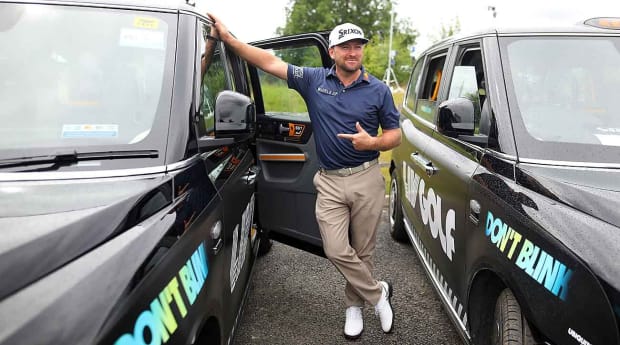
Courtesy of LIV Golf
“The game of golf is very lucky to have the PIF invest in the game,” Mickelson said in Saudi Arabia. “The sport of the game of golf is being influxed with billions of dollars now. And the ability to go global and make golf a truly global sport is really beneficial for the game.”
If the PIF were Warren Buffett or Jeff Bezos or Mark Cuban, there might be a different narrative associated with LIV Golf. The fact that it is Saudi Arabia’s sovereign wealth fund and it is ultimately overseen by the Crown Prince makes for an uneasy relationship, at best.
The clichéd version of the professional caddie is largely a thing of the past. The late-night drinking, hard-charging lifestyle of the vagabond bag carriers has, to a large degree, been replaced by a more businesslike approach. There is too much money to be made, and too many people looking to make it.
Caddies at the highest levels of the professional game are more than just guys who carry the bag. Some serve a role as sports psychologist or coach or security guard or spouse, or all of the above. Many are students of the game. A good number are accomplished players themselves. They are a key part of the team.
That doesn’t mean they won’t take part in the occasional after-hours beverage. And so it wasn’t really a surprise to see a dozen or so caddies in the restaurant/bar at the Jurys Inn in Watford, England, on the night of June 9.
The first round of the first LIV Golf Invitational Series event had been completed a few hours earlier at the nearby Centurion Golf Club, and it turned out the entire 48-player caddie crew was staying in this hotel.
And soon it became clear how life would be different for LIV caddies, too.
With a 2:15 p.m. shotgun start the next day, there was no urgency to get to bed early. Drinks flowed, but money didn’t. Nobody was paying. It was all on the LIV tab. Everything. Including meals, and the rooms in the hotel and the transportation to the course.
“It’s been wonderful,” said Mike Harwood, who has been caddying for Perez for 22 years. “I have to keep pinching myself.”
Harwood wasn’t talking about the booze. He meant the experience in general. Caddies might be among the most frugal people on Earth. They are used to cutting corners. Sometimes they share rooms. Southwest flights are the norm. That’s because they are responsible for their own expenses. And while they are paid a base amount by the player, it doesn’t go very far. If the player misses the cut, there is no commission.
That has changed at LIV Golf. The caddies are part of the team. LIV picks up their airfares and sends them to wherever they are going afterward, even if it’s to caddie in a tournament outside of LIV, anywhere in the world. Hotels, meals, transportation … it’s all covered.
“They put us in some fantastic hotels,” Harwood says. “The Shangri-La in Bangkok. I would never spend the money on myself to stay in a place like that.”
The typical caddie arrangement on the PGA Tour or DP World Tour is a base salary ($2,000–$2,500) a week plus a commission on earnings that usually ranges from 6% to 10%, with the higher number paid out for a victory.
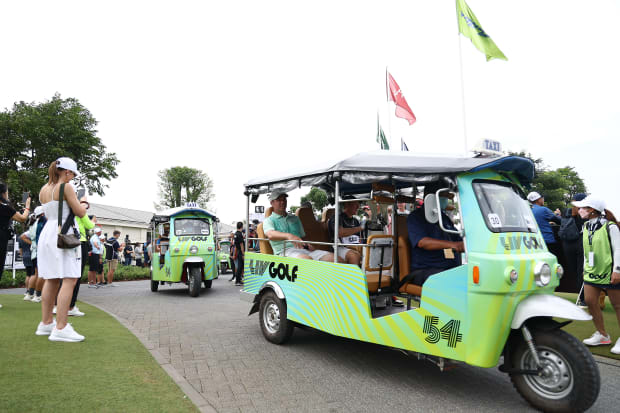
Joe Scarnici/LIV Golf/Getty Images
With expenses no longer an issue, LIV Golf is a money-making proposition for every caddie, given the no-cut format and minimum prize of $120,000 per tournament. Even at the lower end of the pay scale and with a large purse coming this week at Doral, a caddie who worked all eight LIV Golf events in 2022 would stand to make more than $50,000. For most, it will be far more than that. And next year there will be 14 events.
Some of the usual caddie gripes are also eliminated. Because they are provided transportation to the course from the designated hotel, there is no need to rent a car; thus, no need to worry about a possibly lousy parking situation.
And while caddies have a place to eat at PGA Tour events, they are not allowed in the clubhouse. At LIV events, there is no separate dining area. They can eat in the same area as the players and use the clubhouse.
“It’s nice to be taken care of like that,” says Mal Baker, an 18-year veteran caddie who began with countryman Greg Chalmers of Australia and has caddied for Gooch the last few years. “It changes the enjoyment of it. We all do this for a job, and it’s nice when you get a raise. Same for everybody. But we’re included. We’re considered an important part of the tour. We’re not suffered. We’re embraced.”
It wasn’t long ago that caddies were suing the PGA Tour for a part of sponsorship money associated with being required to wear sponsor bibs. They lost that case, but when commissioner Jay Monahan took over from Tim Finchem in 2017, he quickly sought to resolve an issue with caddies concerning health care benefits.
“The strides [the PGA Tour has] made have been incredible,” Baker says. “And for the Tour, it’s a little bit more difficult because there are 140 guys, not 48 [like with LIV]. There might not be room for 140 guys in the same parking lot. Or in the same dining room. I’m always O.K. with that.
“[But] there’s that sense that you are tolerated or you’re accepted as a necessity and not embraced as a part. That’s the difference. For a caddie [LIV] is a can-do tour. If you go to the [PGA] Tour with almost anything, ‘Oh, we can’t do that.’ That’s my sense of experience. … It’s just not the same dynamic.”
The PGA Tour has a structure unlike LIV Golf, as a 501(c)(6) nonprofit categorized as a “business league” that exists to create opportunities for its members (i.e., tournaments for players). It courts sponsors who pay tournament purses, and it sells TV rights that provide billions in operating revenue.
The Tour’s view is that caddies, for the most part, are the players’ responsibility. So why does LIV Golf go to such lengths for them? Part of it is wanting everyone all in and happy. The camaraderie aspect cannot be denied, the sense that they’re all in this together. Another reason: LIV Golf can afford it.
While there has been considerable backlash against players who have left the PGA Tour or DP World Tour to participate in LIV Golf, the same level of angst has not been directed at the caddies. They are going to go where their player goes. It is a job. And it’s turned out to be a lucrative one.
Which means that caddies who are not part of LIV see the opportunities and can’t help but be intrigued. Plenty of text messages of inquiry fly about.
“They are seeing there are opportunities,” Harwood says.
LIV’s motto is “Golf, but Louder.” But in most cases, it’s been golf without an abundance of buzz. Attendance has been modest, to say the least. The presentation has been impressive, but LIV Golf erred early on with high individual ticket prices that it eventually heavily discounted.
While the hospitality venues have been robust, the idea of “growing the game” by getting scores of people onto the course has been missing.
Some of that was by design. At the early events, there was concern about protests given the Saudi ownership, and so LIV Golf limited spectators. No attendance figures have been announced at any event, but it has generally been better on weekends, and certain markets shone. The crowds have skewed younger and more boisterous than most PGA Tour events, matching the vibe of golf played with loud music on most holes.
At the Portland event, there was a significant traffic jam leading to the course on the final day, everyone arriving at around the same time for a shotgun start. While there was a protest by the families of 9/11 victims, most spectators were oblivious to any controversy. They were there to see the golf.
In what turned out to be a common theme, one man said he was there to watch Mickelson. “I might not ever get to see him in person,” he said. “We don’t have men’s professional golf here. So getting to see some of these guys up close is something I wanted to take advantage of.”
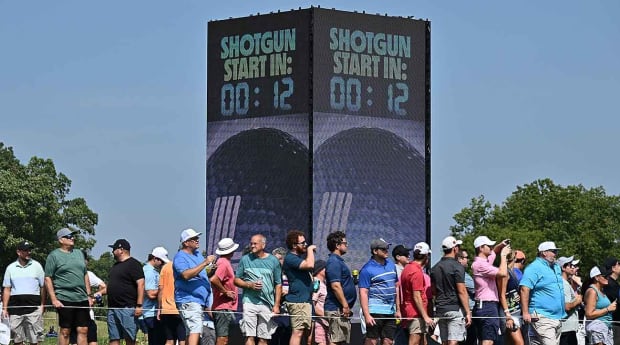
Jamie Sabau/USA TODAY Sports
LIV Golf experienced its best domestic crowds on the weekends of the Boston and Chicago events, both locales without regular PGA Tour golf this year. One of LIV’s mandates is to find places that are underserved.
That was not the goal at the event less than two weeks ago in Saudi Arabia, the home nation of LIV Golf’s funding source. The tournament was played in King Abdullah Economic City, where the population is less than 10,000 people, with a planned development for thousands more slowly emerging.
Jeddah, the commercial center of Saudi Arabia, is more than an hour away, but as one local said, “Even if the tournament were in the middle of downtown Jeddah, I’m not sure the crowds would be much bigger. There might be some curiosity. But this is not a golf country so far. We are rabid about football. And then there’s the heat.”
Saudis are known for sleeping in and working late. High temperatures were in the mid- to high-90s all week, with humidity and a wind that at times felt like a blow dryer. Activity typically picks up as the sun sets, and there was plenty of it once it got dark. Royal Greens Golf & Country Club actually has a lighted back nine; and sure enough, the lights came on as Koepka and Uihlein went to a sudden-death playoff that lasted three holes and pushed the boundaries of the late-afternoon sunset.
Thailand was a different deal. There was genuine support at the Stonehill venue just outside Bangkok, and it even attracted international visitors.
When Paolo Mendoza, 36, heard a tournament was coming to Asia, he found tickets online and made plans to fly from his home in the Philippines with his wife, Vanessa.
On the first day of the tournament, they were perched in a shaded spectator seating area behind the 10th tee that was looking down and only a few yards away from players teeing off.
“This is the first time I’ve ever seen guys like DJ and Koepka,” Mendoza says. “I’m a big Phil fan and I’ve never seen him play, either. And this is big for Asia. We don’t ever get to see these players here.”
Robert Wooten made the journey from Malaysia, where he’s lived for years. An Englishman who relocated to Asia, he was keenly aware of the fight going on between the PGA Tour, DP World Tour and LIV Golf.
“I love Rory McIlroy, but I disagree with him,” Wooten said in reference to many comments the four-time major champion from Northern Ireland has made in reference to LIV Golf. “This is just the evolution of golf. I just think there’s a lot of hypocrisy in golf. I know there’s a lot of stuff said about the Saudis, but look at the PGA Tour and FedEx. Don’t they do business in Saudi? In China? I just don’t think the PGA Tour speaks for everyone else.
“I’m interested to see how it all plays out.”
LIV Golf is unlikely to ever shake the shadow of its benefactor, the Public Investment Fund. It has, so far, pledged some $3 billion to get this off the ground, even though there is no discernable income. There is no TV rights deal. No sponsorships. Very little ticket income. Such spending would seem to be unsustainable.
But then you look into the PIF and see it is estimated to be worth $620 billion, give or take a billion. It has investments in more than 200 companies, including FedEx, Uber and Disney. It has 80% ownership of the Newcastle United Premier League football team. It has brought horse racing, boxing, MMA and golf to the Kingdom.
The fact is that a couple of good days of stock market maneuvering can make up for any money thrown at LIV.
Saudi Arabia’s massive investments are often called “sportswashing,” an attempt to divert attention from the country’s atrocities. The country has an abysmal human rights record, only recently began allowing women to drive, and as protesters at other tournaments pointed out, 15 of the 19 hijackers on 9/11 were from Saudi Arabia.
Norman didn’t help matters when at a June news conference he poorly attempted to discuss the murder of Washington Post journalist and U.S. resident Jamal Khashoggi, whom the U.S. government says was killed at the Saudi consulate in Turkey in October 2018 in retaliation to his negative reporting on the country. The Office of the Director of National Intelligence tied MBS to ordering Khashoggi’s murder, (MBS denied ordering Khashoggi’s killing.)
That kind of baggage is hard to defend for golfers, who typically resort to pleas that they are not political and they are simply taking advantage of a business venture.
A spokesperson for the Saudi Embassy in Washington, D.C., has said sportswashing claims are “off the mark” and Norman has said LIV Golf is “independent” and that the narrative that he answers to MBS is “untrue.” But if the idea is to gloss over all of Saudi’s issues, the plan is hardly working in the short term. Certainly far more negative attention has been brought to Saudi Arabia than positive. Other than Thailand, there has been public questioning at each event about the Saudi ties. It is constantly part of the story.
And yet, as Pat Perez so bluntly offered: “The last time I checked, that private plane Jay Monahan is flying around in isn’t a Tesla. I’m not aware of any oil fields in Jacksonville.” The reference is to the fact that Americans—and the PGA Tour commissioner based in Florida—rely on oil from Saudi Arabia, a common, albeit oversimplified point of pushback when the issue is broached.
If you were unaware of all the baggage that Saudi Arabia and the PIF bring, attending an LIV event likely would not change that. There is no outward sign of who is involved. There is no Saudi branding, not even for Golf Saudi, the promotional sports arm that runs the Saudi International.
LIV Golf is incorporated in Delaware and has offices in West Palm Beach, Fla., and London. It has more than 100 full-time employees and plans to pass 200 by the end of the year. That doesn’t include more than 100 freelance production people it hires each week to put on the broadcast. Nor does it include the management companies it hires to help run events—Performance 54, based outside of London, and an American company called Par 5 Group, formed to help domestic events.
Aside from the opening event outside of London, Al-Rumayyan has mostly been behind the scenes. He has played in a few of the pro-ams, which have not been open to the public, and he was seen in a golf course hospitality venue alongside former President Donald Trump when the third event was played at the Bedminister course outside of New York.
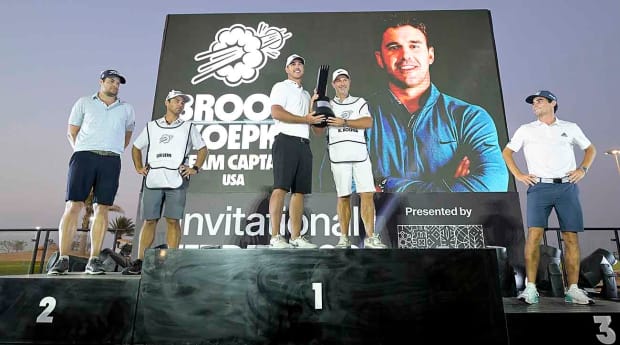
Courtesy of LIV Golf
Because of the Foreign Agents Registration Act (which requires “foreign agents” to register with the Department of Justice and disclose “their relationship, activities and related financial compensation”), LIV Golf is careful about drawing a line between its interests and those of the Saudi government. This is why there is no Saudi Golf signage or anything promoting the country at LIV Golf events.
So what is the end game?
Norman has spoken about “growing the game” and bringing it to new markets while putting his legacy and reputation at stake. LIV Golf Investments, the parent company of LIV Golf, has made a $300 million commitment over 10 years to the Asian Tour to produce an elevated group of events known as the International Series. There's an influx of cash going to golfers, caddies, agents and the hundreds of people who work for or on behalf of LIV Golf.
The investment is likely related to Saudi Vision 2030, the government initiative put in place to reduce the country’s independence on oil and diversify its economy. First introduced by MBS in 2016, part of it included the issuing of tourist visas for the first time in ’19.
So the goals, as far as golf is concerned, remain unclear. Sportswashing is certainly not working in the short term, but getting foreign investment seems a reasonable goal—which ultimately may play a part in enhancing the country’s image.
As it relates to the current golf climate? It has created a lot of heat, none of which seems to be cooling off anytime soon.
Koepka has always presented himself as the tough-guy athlete who didn’t really like golf all that much and was more concerned with winning the biggest trophies. He came to be known as a major championship warrior, winning four of them from 2017 to ’19 and contending in several others. He made it clear he didn’t much care for the small stuff, and when he won the WM Phoenix Open in 2021, only then did he match his major total of four wins with four other PGA Tour victories.
But along the way, Koepka was piling up injuries. To both knees. His hip. A wrist. It was one thing after another, with long bouts of inactivity or rushing back too soon. Some wondered whether Koepka questioned his longevity and saw that as a reason to take the easy LIV money.
So it was interesting to see Koepka become teary-eyed after his victory in Jeddah. It hadn’t previously appeared that any major title had moved him this much. He had joined LIV Golf somewhat defiantly, getting angry at questioning preceding the U.S. Open, only to sign on a few days later—and just weeks after Monahan had attended his wedding.
Success was slow to come, too. His best finish before winning was a tie for ninth in Bangkok.
His playoff victory meant a $4 million payday, plus $750,000 for winning the team event. In five events, he earned $6,776,100. That’s on top of the $38 million in official earnings on the PGA Tour and the reported $100-million-plus contract he signed to join LIV Golf.
But a few tears still moistened after his victory. Perhaps there is some meaning in the fight after all.
“I blew my knee out, and my foot was pointed backwards and sideways,” Koepka said in an emotional post-round interview. “The last two years, they haven’t been fun. It’s been a long road. I didn’t know if my career was over for half-second. I wasn’t sure I was going to play.
“So it’s nice to be able to come back and win.”
Soon, it was back to LIV Golf craziness. Koepka’s Smash team had won the competition, so Uihlein, Jason Kokrak and Chase Koepka, Brooks’s younger brother, were also at the podium.
Chase Koepka, who has never had full status on the PGA Tour, had won $750,000 for the team victory and a total of $2,828,964 in seven events. If there’s some nepotism involved there, it only gets better, as Chase had a wide grin while his brother spoke.
“Honestly, to me the big thing today was getting the team win,” Brooks Koepka said. “I told my brother I’d buy him a Lambo if we won the team thing. So now I’ve got to go buy one.”







